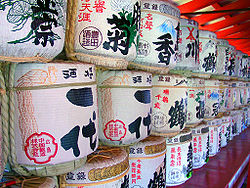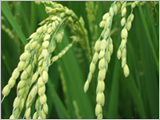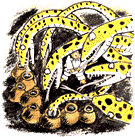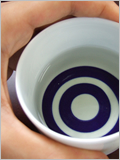|
 Sake is a traditional Japanese alcoholic
beverage. Since ancient times sake has been believed to have spiritual powers,
so it is an integral part of special occasions, such as ceremonies and
festivals. Sake is a traditional Japanese alcoholic
beverage. Since ancient times sake has been believed to have spiritual powers,
so it is an integral part of special occasions, such as ceremonies and
festivals.
≪Characteristics of Sake≫
Sake is a fermented alcoholic drink made
from rice with an alcohol content of between 15% and 20%. Wine and beer are
also made through fermentation, but the production process is different.
Grapes, the main ingredient of wine, contain sugar, so they ferment naturally
after being pressed. As rice doesn’t contain sugar, the starch must be changed
into sugar. The saccharification(糖化) and fermentation processes occur in parallel, so it is called “multiple
parallel fermentation”. Through this elaborate process, a unique flavor is
created. Comparing amino acid content, which is considered to be the basis of
flavor, beer has a rating of 1; wine 3, and sake 8.
≪The History of Sake≫
More than 2000 years ago when rice
cultivation started, sake brewing also began. People chewed rice to convert the
starch into sugar, and then it was fermented using natural yeast. In the 3rd
century B.C. there is a mention of Japanese sake in the Chinese historiography,
Gishi-wajin-den: “People dance and drink sake”. In the 8th century a local
record book, Harima-no-kuni Fudoki, says “sake was brewed using rice mold (麹)”.
After  the national system was set up and the nation was governed by official
law, sake came to be considered indispensable as a symbol of good harvests,
and sake brewing came under the control of the state. In the Heian period
when the manor system (荘園) came into
existence and the landowners took power, they and local temples began brewing.
In the Muromachi era rice mold became accessible to everyone, and sake brewing
flourished. the national system was set up and the nation was governed by official
law, sake came to be considered indispensable as a symbol of good harvests,
and sake brewing came under the control of the state. In the Heian period
when the manor system (荘園) came into
existence and the landowners took power, they and local temples began brewing.
In the Muromachi era rice mold became accessible to everyone, and sake brewing
flourished.
≪How to make
Sake≫
Brewer’s Brown Rice・Special
rice for sake: large grain, low protein content and higher absorbency.
↓ ←Polish How much the rice is polished determines what kind of sake can
↓ be made. Rice polished to less than 50% is for daiginjyo – top quality sake.
Polished Rice
↓← Rinse・Soak・Steam
Steamed Rice・・・Steamed rice is divided into three for making
rice malt (米麹), what is known as “mother of sake酒母),
and unrefined sake (醪).
↓←Cool・Making Rice Malt add
rice mold*
Rice Malt *an enzyme in rice mold converts starch into glucose. ↓←Making Mother of Sake add steamed rice, water and yeast
Mother of Sake
↓←Fermentation(Sandan-jikomi) add
rice malt, steamed rice, and water in three stages so the yeast ferments
Unrefined Sake
↓←Filtration
Filter unrefined sake. What remains are sake lees.
Refined
Sake
It takes about 60 days to make sake.
≪Sake Trivia≫
It’s good for
cooking・・Sake contains about 200 flavor components which
produce a distinctive taste. Sake is a perfect hidden ingredient for every cuisine,
or can be used as an all-round seasoning.
It’s good for
beauty・・Koji mold contains ingredients that suppress the
production of melanin, which is the main cause for freckles or moles, so it’s
good for skin whitening and moisturizing. It can also slow cellular aging.
It’s good for your
health・・Sake contains more than 100 ingredients,  including organic acid, essential amino acid, vitamins, peptide, which
work to prevent osteoporosis, inhibit allergies or high blood pressure,
delay senile dementia and so on. A saying that “sake is the chief of all
medicine” is true. However, please don’t over-indulge! including organic acid, essential amino acid, vitamins, peptide, which
work to prevent osteoporosis, inhibit allergies or high blood pressure,
delay senile dementia and so on. A saying that “sake is the chief of all
medicine” is true. However, please don’t over-indulge!
|